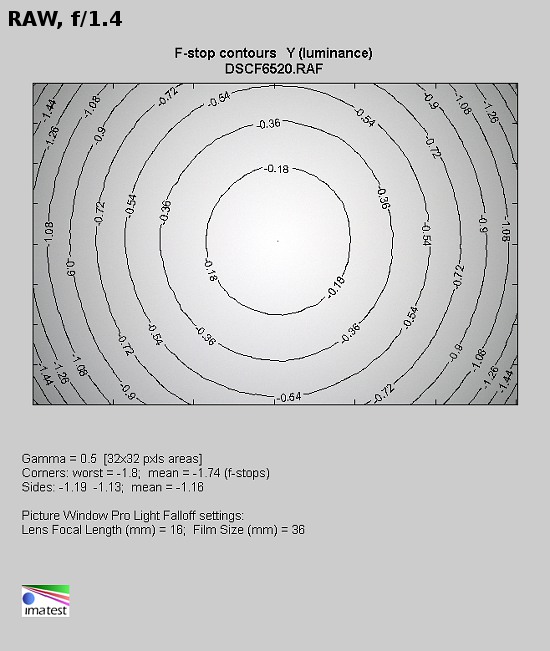Fujifilm Fujinon XF 35 mm f/1.4 R
8. Vignetting
| JPEG | RAW |
| f/1.4 | f/1.4 |

|

|
| f/2.0 | f/2.0 |

|

|
| f/2.8 | f/2.8 |

|

|
In the case of JPEG files the vignetting is not a serious problem. At the maximum relative aperture it amounts to 24% (-0.79 EV) and it decreases to 17% (-0.55 EV) by f/2.0. What’s interesting, further stopping down helps very slightly because by f/2.8 the brightness loss in the corners gets to just 13% (-0.39 EV) and by f/4.0 it is 10% (-0.30 EV).
Please Support UsIf you enjoy our reviews and articles, and you want us to continue our work please, support our website by donating through PayPal. The funds are going to be used for paying our editorial team, renting servers, and equipping our testing studio; only that way we will be able to continue providing you interesting content for free. |
- - - - - - - - - - - - - - - - - - - - - - - - - - - - - - - - - - - - - - - - - - - - - - - -
As we mentioned the real performance of the optics of the tested lens can be assessed only on RAW files. Here the vignetting is showed in all its glory. At the maximum relative aperture it reaches a very high value of 45% (-1.74 EV) and it is still visible on stopping down to f/2.0, where it gets to 28% (-0.95 EV). The aberration becomes moderate by f/2.8 and f/4.0, where it is respectively 18% (−0.60 EV) and 15% (−0.46 EV). Further stopping down doesn’t cause any measurable decrease of that aberration.
The chart below shows a comparison between the results of the Fujinon and other standard lenses, designed for smaller sensors. The Fujinon loses the duel with the Sigma even though its field of view is a bit smaller so easier to correct. Perhaps a small distance between the rear element and its sensor is to blame – in mirrorless systems it might cause telecentricity problems. Compared to 1.8/35 instruments the Fujinon, with its faster relative aperture, is better for a change, showing the vignetting more or less the same as them. On stopping down to f/2.0 the Fujinon’s results are definitely the best.
|
|
Fujinon 1.4/35 |
Sony DT 1.8/35 |
Nikkor 1.8/35 |
Sigma 1.4/30 |
| f/1.4–1.8 |
45% |
44% |
37% |
35% |
| f/2.0 |
28% |
39% |
31% |
28% |
| f/2.8 |
18% |
14% |
22% |
22% |
To sum up in this category the tested lens doesn’t impress much. A noticeable defeat with the Sigma 1.4/30, with a bit wider angle of view, gives a lot food for thought. Perhaps the constructors focused too much on small physical dimensions of this lens. Currently the Fujinon 1.4/35 fits very well the X-Pro1 body but even if it was slightly bigger the whole set wouldn’t lose its nifty shape and it would still remain physically light; still constructing a bigger lens might have prevented the vignetting problems and improved the image quality on the edge of the frame.
 |






